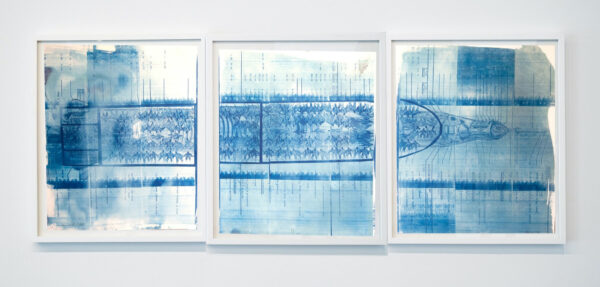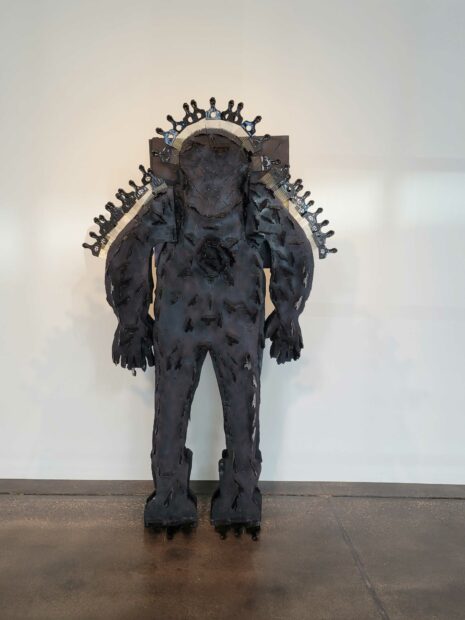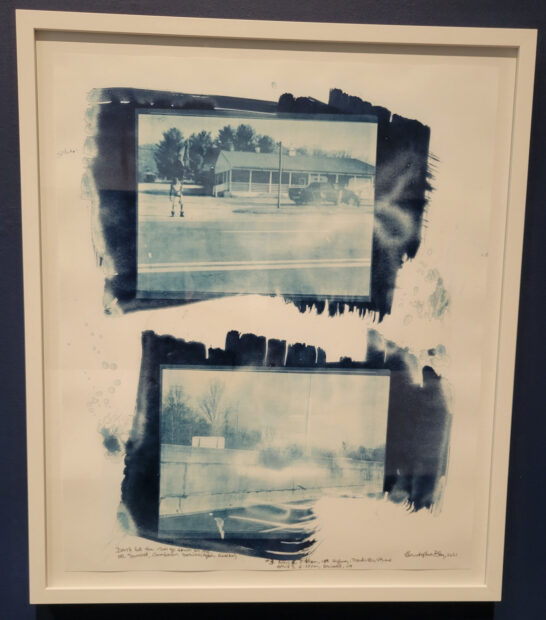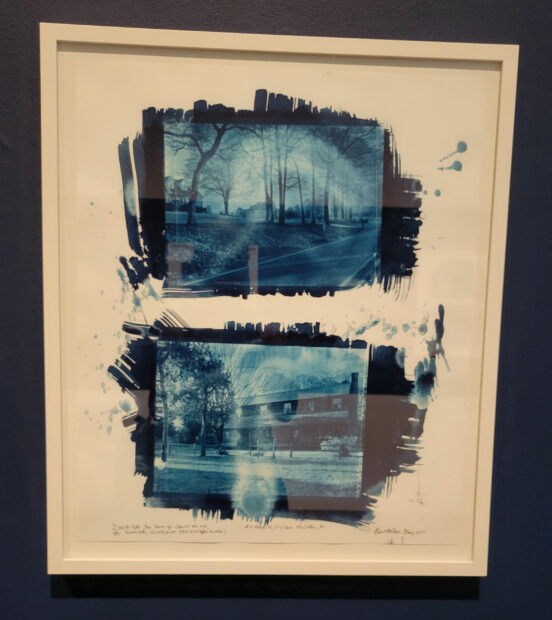Time is a widespread conceit. As humans, it is easier to think of time as linear and progressive; the forward march of history to a better world. What if the timeline, however, is not so clear? What if past and future can be melded to form a better present? Christopher Blay / SpLaVCe Ship, on view at Barry Whistler Gallery, explores that relationship. In a body of work that aligns with Afrofuturism, a cultural and philosophical movement centering African diaspora communities in science of fiction, Blay invites viewers to contend with African American history while envisioning a new path forward.

Christopher Blay, “Power Lines #11,” 2022, twisted afro picks, on organic roofing felt, 11 x 8 ½ inches
Upon entering the gallery, Blay’s Power Lines series greets visitors, setting the stage for what they will experience. In these works, Blay celebrates the hair pick — a comb typically used to style thickly textured and coily Black hair — and utilizes it as a symbol of strength and resilience. Black Power fists serve as the handles of each pick, with metal tines surging out in unique angular formations. I strongly encourage visitors to take note of the titles of Blay’s works, which are carefully crafted to highlight the symbolism embedded in each piece.
A great example is the Power Lines series. The term “line” has multiple meanings. It can refer to lineage, or ancestry; when referring to African Americans, the notion of lineage is quite fraught. Black families have been intentionally disrupted and used as a tool of White supremacy during slavery, the centuries that followed, and into the present day. Yet, African Americans have found ways to reconstruct families and draw power from that support and community. The tines of the comb may be bent or severed, but they continue. There is not a loss of power, just a change of course.
There is also a reference to power or electric lines in this body of work, like a notion of energy — an allusion many present-day questions about the sustainability and reliability of our power sources. We also must question how we power ourselves as individuals, and convert our own energy into a collective power.
The year 2020 served as an important marker in the movement for social justice in the United States. It galvanized large numbers of people of diverse backgrounds, and made them pool their energy in the fight for inclusivity and equity. As I look at Blay’s works, I cannot help but wonder what’s next. How do we, those in the movement for equity and justice, continue to grow our collective power and plug that energy into the efforts that will bring about meaningful change? How can we look to the past and draw strength from it while forging a radically different future?

Christopher Blay, “Blueprint for America and SpLaVCe Ship,” 2022, cyanotype on hahnemuhle paper, 24 x 20 inches
Blay has long tackled social justice in his artistic practice. His newest series SpLaVCe Ship, featuring works on paper and sculptural works, blends his interest in science fiction with Black history. Blueprint for America and SpLaVCe Ship sets the stage for the project. On the left of this cyanotype is the Diaspronaut, the protagonist of Blay’s narrative. It is Blay’s fictional character of a future Diasporan being, with long tentacle-like extremities, that will travel through space to settle a new home. To create this figure, he layers the afro picks from Power Lines with the image of an early space suit. In the center of the work is the familiar image of the layout of an African slave ship, inhumanely transporting hundreds of human beings in rows and stacks across the Middle Passage. A blueprint of a rocket ship occupies the right side, showing the transition from past to future. While Black bodies were forcibly moved by slave ship to the Americas, going forward, Black people will assert their agency and make their next moves via space ship.

Christopher Blay, “SpLaVCeShip,” 2022, cyanotype on hahnemuhle paper, set of three, 24 x 20 inches, each
Blay’s vision comes to life in SpLaVCeShip, which is a combination of the three images into a singular artwork. In this cyanotype, Blay overlays the blueprint of the slave ship onto the blueprint of the rocket, but partially clad Black bodies no longer occupy the vessel. Instead, Blay substitutes his Diaspronauts into the ship, repeating his futurist figures atop the figures of the past.

Christopher Blay, “Untitled (Diaspronaut),” 2022, black spray paint on insulation foam, metal rods, and afro picks, 84 x 48 x 24 inches
In the second gallery, Blay’s narrative takes monumental form, from large renderings of the SpLaVCe Kru on organic roofing felt to The SpLaVCe Ship, a three-dimensional model of the ship made of steel, wood, and painted canvas. The work in this section that lingered with me most was Untitled (Diaspronaut). This life-sized figure, apparently in a space suit, is striking in its solid blackness. The use of insulation foam provides a built-out form that enhances its presence. Afro picks jut out from this solid black form, which shares qualities with Kongo nkisi sculptures. Nkisi are power figures in the Kongo tradition, providing protection and power to the owner. I cannot help but wonder if this is Blay’s effort to give Black people from the diaspora a large-scale power figure that provides protection and medicine as new chapters are written in our history.

Christopher Blay, “Don’t Let the Sun Go Down on Me, or Sunset/Sundown Series (after Ed. Ruscha), #3 April 6, 5:46 PM, Lee Highway, Troutville, VA, and April 6, 6:38 PM, Bristol, VA,” 2021, cyanotype on hahnemuhle paper, 20 x 24 inches
The medium of cyanotypes returns in the back section of the gallery with Blay’s Don’t Let the Sun Go Down on Me, or Sunset/Sundown Series (after Ed. Ruscha). Created during a road trip taken by Blay in April 2021 from Houston to Washington, D.C., this series is as much a performative piece as a tangible work on paper. In many of the images, Blay strikes a nostalgic cord, reminding viewers of the many hours spent staring out of the car window during yet another long road trip.
One piece, #3 April 6, 5:46 PM, Lee Highway, Troutville, VA, and April 6, 6:38 PM, Bristol, VA is less serene and more confrontational. In the top image, one looks across a road to the parking lot of a farmhouse-style business and a dark pickup truck. While this is not an uncommon sight in most areas of the United States, in this image a figure appears to be standing in the drive of the parking lot, wearing combat-style boots and holding a flag. In this cyanotype, it is hard to make out what flag is being displayed, but considering the image was taken in Virginia (and the recent history of white supremacist rallies there), the mind automatically starts guessing.
In the work’s other image, Blay captures a view from the road with a bright Christian cross at its center. The United States has long been considered a Christian nation, and Virginia certainly falls into the Evangelical Bible belt. To be clear, while there is nothing necessarily jarring about a cross for this viewer, even I found the location, scale, and shade of the cross to be a confrontation.
First, it is a large cross directly in the center of the image, commanding the viewer’s attention, while a United States flag looks paltry in comparison just to the right. Why was such a large cross placed here? What is being asserted about the role of Christianity in this particular place? Considering the debates about religious freedom and the restrictions of particular rights in accordance with Christian values, I cannot help but view this as an attempt to re-impress Christianity upon those passing.
Then, there is the bright tone of the cross. Those who have made a sunprint before will know that objects laid over the light-sensitive paper block the light, making an area appear lighter than the surrounding, unshielded area. In this case, the cross appears quite bright. Again, considering the context of this image, which was captured in Virginia, the mind cannot help but wander to the idea of burning crosses meant to intimidate Black people.

Christopher Blay, “Don’t Let the Sun Go Down on Me, or Sunset/Sundown Series (after Ed. Ruscha), #4 April 5, 7:37 AM, McCalla, AL,” 2021, cyanotype on hahnemuhle paper, 20 x 24 inches
#4 April 5, 7:37 AM, McCalla, AL captures the stately homes that dot the landscape Blay traveled. What is remarkable is the especially early time of morning that the photograph was taken. Were others aware of Blay’s presence, capturing images of homes and businesses? If so, what did they think? These questions get at the heart of the project and are part of his response to Ruscha. While Ruscha had the freedom to travel along Sunset Boulevard taking images, Black men like Blay cannot navigate communities as freely or safely. This also relates to his use of the term “Sundown” in the title of the series, referring to the many sundown towns that existed during the Jim Crow era, and arguably still exist today. In these places, Blacks experienced/still experience violence if found within city limits at night. Blay’s project is not only a creative documentation of his travels through the American landscape, but also a transgressive performance that explores his own mobility.
Christopher Blay / SpLaVCE Ship takes visitors on a remarkable journey through past, present, and future. Through exceptional works, both paper-based and sculptural, viewers are invited to engage with challenging concepts, but leave with a sense of hope. Blay has provided us with his creative idea of what a future could look like. He gives us a starting point to interrogate how we will take our past and continue to explore our ability to take new paths in the present to create a new narrative for African diasporan life in the future.
Christopher Blay / SpLaVCE Ship is on view at Barry Whistler Gallery in Dallas through October 15, 2022.


